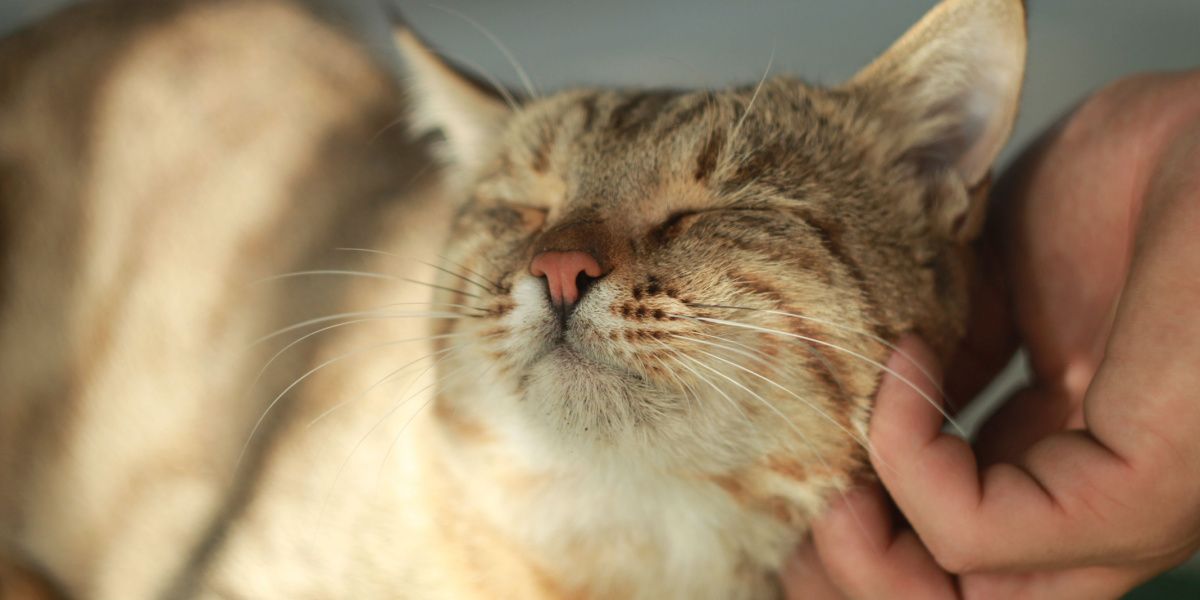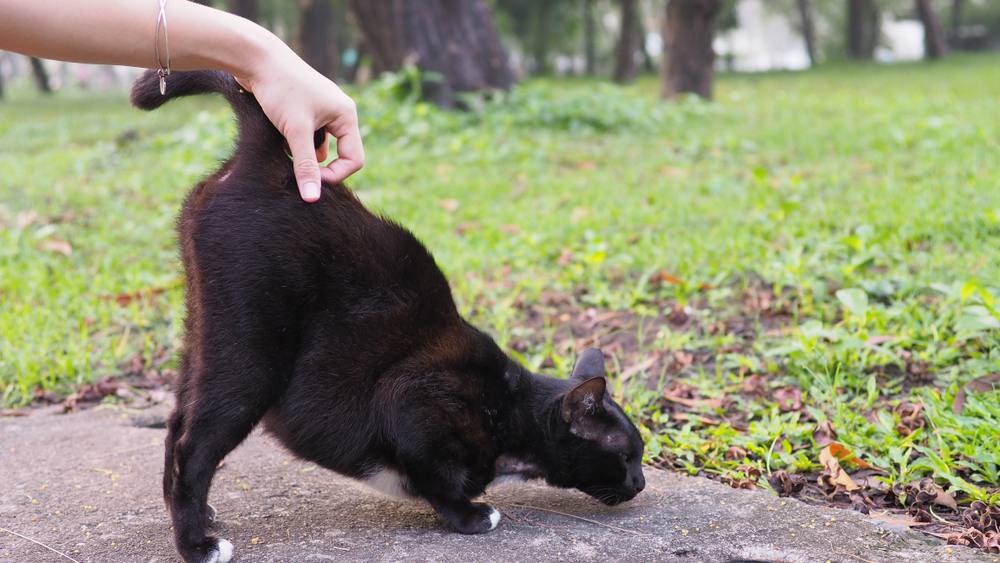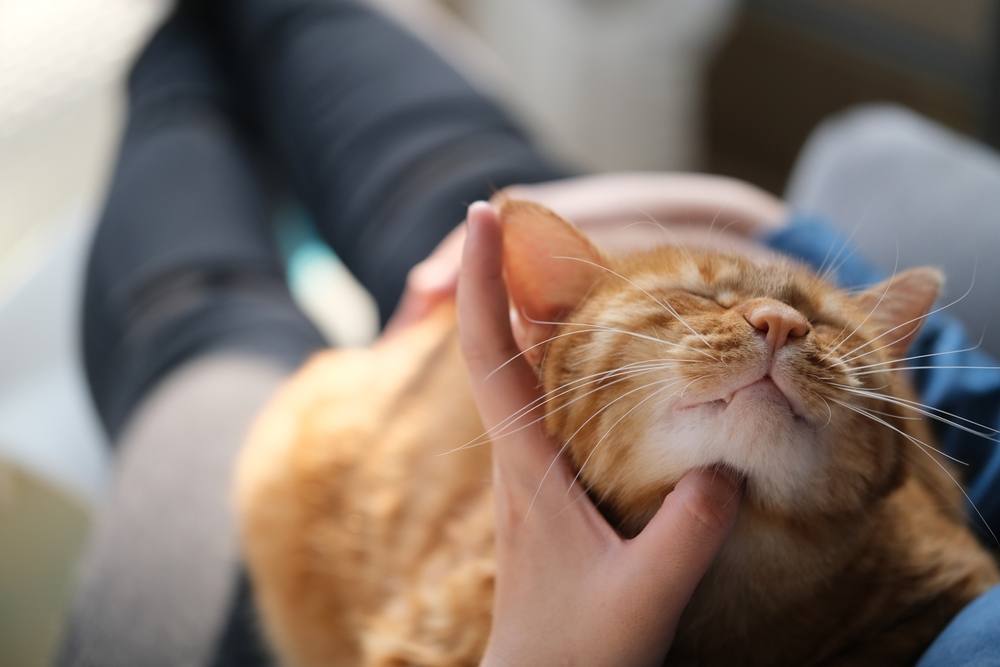
Shutterstock
Tickling is not well understood in the scientific world, let alone the feline world. Cats don’t laugh like we do when tickled, but that doesn’t mean they don’t enjoy a gentle tickling motion as a form of affection from time to time.
As a vet and the proud owner of two cats—one who loves a firm tickle all over his body and one who only likes a gentle rubbing around her cheeks and chin—I know how important it is to get to know your cat and how they like to be petted.
There are two types of tickling: one that leads to involuntary laughter and one that causes an itch or urge to scratch.
Cats will experience that urge to scratch a tickled spot but they will not experience any giggle fits.
To strengthen your bond, it's important to learn what kind of physical affection your cat likes and dislikes. Key Takeaways
The Science of Tickling
While you have probably experienced tickling—perhaps you’ve been tickled and you’ve been the source of the tickling attacks—it can be hard to explain exactly what it is.
Did you know there are actually two scientifically defined forms of tickling?[1]
The first type of tickle is called gargalesis. This is the typical sensitivity whereby when you are poked or prodded in a ticklish spot, it produces involuntary laughter. The sensation is unique and fairly hard to describe. Many people don’t like it, which is understandable as this type of tickling leads to the activation of both pleasure and pain receptors. This helps explain the somewhat uncomfortable feeling that goes alongside the laughter when being tickled.
The other kind of tickling sensation is called knismesis. This describes the funny feeling you get through a very light touch across the skin. When you experience knismesis, you may have the sudden need to itch or scratch, but it doesn’t tend to make you laugh. In fact, it can be more of an annoyance.
You can produce knismesis on yourself with a light brush across the skin, but you cannot experience gargalesis without someone else tickling you.
Are Cats Ticklish?

Cats display unique body language in response to how they are petted, which helps their owners learn how they like to be petted. Shutterstock
The knismesis scratch-type response to a light, ticklish touch is well-recorded in mammals, including both cats and dogs. In fact, this response actually serves a useful purpose. It can alert animals to the presence of insects or parasites and prompt them to itch or rub at the area, removing the problem.
The “classic” ticklishness of gargalesis that produces an involuntary laughter response in humans is more difficult to find examples of in other mammals. Research suggests that some primate species, such as chimpanzees,[1] do tickle each other during rough-and-tumble play. However, the phenomenon is not well documented in other species.
It’s not thought that cats can experience the same tickle sensation as we do. This type of behavior has not been observed between cats and they don’t have the same ability to laugh as we do.
Do Cats Like a Tickle?
Cats don’t laugh, as such, but they do express pleasure and joy in other ways, such as purring. They may not experience gargalesis, but they can still enjoy an affectionate tickle in the right spot.
Most cats enjoy a gentle tickling under their chin or along their cheeks. Try stroking gently along your cat’s back and tickling just above the tail. You’ll soon work out where on your cat’s body they like to be stroked or tickled.
Avoid tickling your cat’s paws, which are very sensitive; they will often draw them away or tuck them under their body if touched. Another known area of sensitivity is a cat’s belly. They look so fluffy and adorable when they roll on their backs, but this is rarely an invitation to tickle.
Observe your cat’s body language to tell if they’re enjoying the sensations. They may purr, nudge you back with their head, or knead you with their front paws. When your cat has had enough, they may swat at you, become very tense with eyes wide and ears back, or even vocalize through hissing or growling.
Some cats experience petting aggression, and if this is the case, you can try other forms of bonding, such as cuddling, play sessions, or grooming.
When to Worry About Tickling Responses

Many cats enjoy a gentle tickle or scratch under their chin. Shutterstock.
It’s important to know when to stop touching your cat. The stronger your bond, the easier it is to tell when they are beginning to get annoyed. Some cats like more rough and tumble, while others prefer a gentle stroke.
Sometimes when a cat is touched in a certain way, it causes a reaction that makes their skin look like it’s rippling or twitching across their back. If your cat is showing this behavior, take them to a veterinarian. They may have a medical condition causing skin sensitivity. This could be something as simple as fleas, or it could be something a bit more complicated such as allergies. Feline hyperesthesia syndrome is a distressing condition that can lead to extreme sensitivity and even self-trauma to the skin.
That said, in most cases, cats will enjoy some gentle tickling. This is especially true of favorite areas such as the chin and sides of the body. Just don’t expect them to break out into laughter!
Frequently Asked Questions
Where are cats ticklish?
Most cats enjoy a gentle tickle under their chin or along their cheeks. Cats are most sensitive around their belly and paws, so touch here may result in a more ticklish or extreme reaction and is not enjoyed by many cats.
Why do cats spread their toes when you tickle them?
Cats have lots of nerve receptors in their feet designed to sense pressure, temperature, and touch. Many cats pull their feet away when touched but some respond positively. Their toes may spread in response to the ticklish sensation to a sensitive area.
How does a cat laugh?
Cats don’t laugh like humans do. They can show pleasure, affection, and joy through other means, such as purring, rubbing their head against you, and giving you slow blinks with their eyes.
-
Harris, C. R. (2012). Tickling. University of California, San Diego.







